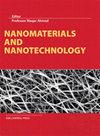基于Au@ZnO/Fe3O4抑制Hg (II)诱导4-硝基酚类酶还原的美容护肤品中Hg (II)的快速比色检测
IF 3.3
3区 材料科学
Q2 MATERIALS SCIENCE, MULTIDISCIPLINARY
引用次数: 0
摘要
本文合成了包金ZnO/Fe3O4纳米复合材料。首先,我们将Fe3+和Fe2+作为沉淀剂在氨水下共沉淀,制备了Fe3O4磁性纳米颗粒。然后,将合成的磁性纳米颗粒分散到碱性硝酸锌溶液中制备ZnO/Fe3O4复合材料。将沉淀煅烧后的ZnO/Fe3O4复合材料分散在金酸/乙二醇溶液中,在水浴中涂覆金纳米结构。合成的Au@ZnO/Fe3O4杂化材料能够催化4-硝基苯酚(4-NP)还原为4-氨基苯酚(4-AP)。我们证明了这种催化活性可以用于检测化妆品中的Hg2+离子。在Hg2+离子存在下,Au@ZnO/Fe3O4的催化活性受到极大抑制。这一新发现奠定了一种直接、灵敏、高选择性的Hg2+探测探针的基础。该材料的极低检出限(LOD)为2.34 nM,远低于美国食品药品监督管理局(FDA)规定的化妆品中汞的可接受限(4.99 μM),线性动态范围为0 ~ 10 nM,具有优异的分析性能。回收率在96.5 ~ 100.3%之间,对Hg2+具有较好的选择性。本文章由计算机程序翻译,如有差异,请以英文原文为准。
Rapid Colorimetric Detection of Hg (II) Based on Hg (II)-Induced Suppressed Enzyme-Like Reduction of 4-Nitrophenol by Au@ZnO/Fe3O4 in a Cosmetic Skin Product
Herein, we synthesized gold-coated ZnO/Fe3O4 nanocomposites. Initially, we prepared Fe3O4 magnetic nanoparticles based on the co-precipitation of Fe3+ and Fe2+ under aqueous ammonia as a precipitating agent. Thereafter, the ZnO/Fe3O4 composite was prepared by dispersing the synthesized magnetic nanoparticles into an alkaline zinc nitrate solution. After calcination of the precipitate, the formed ZnO/Fe3O4 composites were coated with gold nanostructures by dispersing the composites in auric acid/ethylene glycol solution in a water bath. The synthesized Au@ZnO/Fe3O4 hybrid material was able to catalyze the reduction of 4-nitrophenol (4-NP) to 4-aminophenol (4-AP). We demonstrate that this catalytic activity can be exploited for the detection of Hg2+ ions in a cosmetic product. In the presence of Hg2+ ions, the catalytic activity of Au@ZnO/Fe3O4 was greatly suppressed. This novel finding underlies a straightforward, sensitive, and highly selective detection probe for Hg2+. The material exhibited excellent analytical performance as marked by the very low limit of detection (LOD) of 2.34 nM, which was well below acceptable levels of 4.99 μM for mercury in cosmetics as set by the US Food and Drug Administration (FDA), and within the linear dynamic ranges of 0–10 nM. High recoveries ranging from 96.5 to 100.3% accompanied by excellent selectivities toward Hg2+ over potentially interfering species were obtained.
求助全文
通过发布文献求助,成功后即可免费获取论文全文。
去求助
来源期刊

Nanomaterials and Nanotechnology
NANOSCIENCE & NANOTECHNOLOGY-MATERIALS SCIENCE, MULTIDISCIPLINARY
CiteScore
7.20
自引率
21.60%
发文量
13
审稿时长
15 weeks
期刊介绍:
Nanomaterials and Nanotechnology is a JCR ranked, peer-reviewed open access journal addressed to a cross-disciplinary readership including scientists, researchers and professionals in both academia and industry with an interest in nanoscience and nanotechnology. The scope comprises (but is not limited to) the fundamental aspects and applications of nanoscience and nanotechnology
 求助内容:
求助内容: 应助结果提醒方式:
应助结果提醒方式:


